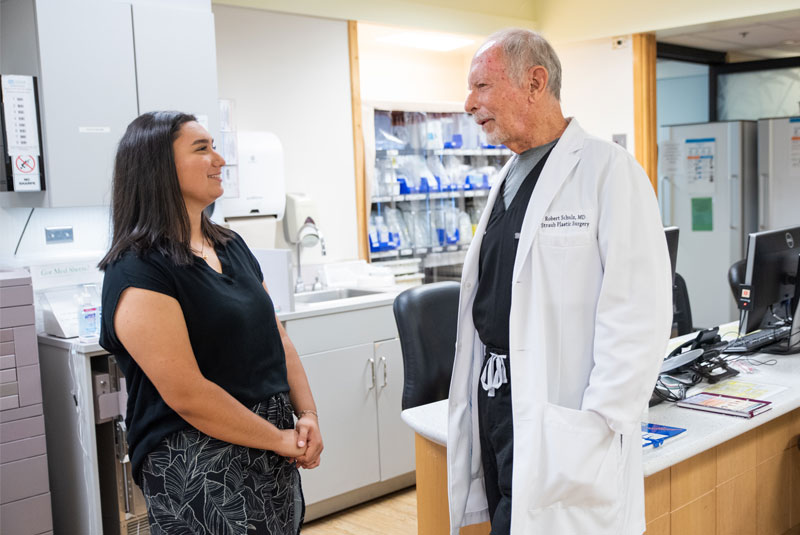Inspire 2023
Straub: A Teen’s Triumph


Burn survivor Malia Valona proudly shows off her scars with her parents, Jesse (left) and Barbara.
The kitchen is one of Malia Valona’s favorite places. She's been baking and cooking with her mom, Barbara, since she was in elementary school. One summer day three years ago, the then 13-year-old started preparing simple syrup for a batch of hard candy. She mixed sugar and water in a bowl and heated it in the microwave. But when she placed the hot glass bowl on the counter, it exploded, sending scalding hot liquid and shards of glass showering down on Malia’s legs.
Malia’s two brothers heard her cries and ran into the kitchen. One helped her into the bathtub to try and cool her wounds with water, while the other called their mom at work.
“My oldest son told me Malia had been burned, but I didn’t know how bad it was until I asked him to send me a picture,” Barbara said. “Once I saw her legs, my husband and I rushed home. I knew we had to go to the hospital.”
A kitchen burn like this could have happened to anyone. In fact, scald burns like Malia’s are the most common, according to the American Burn Association. Injuries can be very painful and serious. The microwave is also a common source of serious burn injuries. Many scald burns happen when people try to remove hot foods and liquids from the microwave.
At Straub Medical Center, Dr. Robert Schulz, co-founder and medical director of the Burn Unit examined Malia’s injuries. The young teenager had first-degree and deep second-degree burns all over her legs. Dr. Schulz told the Valonas that she would need to be admitted to the Burn Unit.
“It was scary. I hadn’t been admitted to a hospital before,” Malia said. “I cried. It was the first time I shed a tear up to that point in my recovery. I didn’t know what was going to happen.”

Malia visits her doctor, Dr. Robert Schulz, co-founder and medical director of Straub’s Burn Unit.
Malia had a long journey ahead of her. Recovering from a burn is often a complex and painful process. Every physician and nurse at the Burn Unit is Advanced Burn Life Support certified, meaning they are specially trained to treat patients in those crucial first 24 hours. From the moment Malia arrived at Straub, they worked to fight the No. 1 risk for patients — infection. Nurses cleaned and dressed her wounds twice a day for the first week, a process that can take about an hour each time. Healing Malia's physical wounds was just one part of her care.
“Burn care is a coordinated, multidisciplinary approach,” Dr. Schulz said. “Each patient has an entire team to help him or her through the healing and rehabilitation process. This includes nurses, pharmacists, physical and occupational therapists, dietitians, psychologists, social workers and the hospital chaplain.”
Malia went through weeks of physical therapy to regain her full range of motion. The Burn Unit team made sure she received proper nutrition and the right medications. Malia’s mom or dad stayed with her every night to support her recovery. She was in the Burn Unit for a total of 30 days.
“The nurses and Dr. Schulz were wonderful — they were true heroes,” Barbara said. “It was really the level of compassion shown by the entire team at Straub that helped us through that time.”
Straub is the only place in the entire Pacific Region where Malia could have received the specialized care she needed. Since the Burn Unit opened in 1983, Dr. Schulz and his team have provided lifesaving care for thousands of patients with thermal, electrical and chemical burns as well as severe skin diseases. Before that, patients with serious burns, who were often in severe pain and medically fragile, had to travel to the mainland for treatment.
The success of the Burn Unit is not only because of its dedicated team, but it is also a reflection of the commitment of the community. Most of the specialized equipment is funded by donations and gifts. The Atherton Family Foundation, Bank of Hawaii Foundation, First Hawaiian Bank Foundation and the Honolulu Firefighters Foundation have donated more than $525,000, collectively. The gifts have helped purchase the latest technology, including a hydrotherapy system wet room with a specialized shower and heated ceiling tiles to regulate patient body temperatures, shower gurneys and burn-care mattresses to alleviate pain from pressure and minimize infection. The Burn Unit will soon have a new interactive 3D system that provides patients games and activities to focus on, distracting them from what can be painful treatments.
Today, Malia is a 16-year-old junior in high school who still loves to spend time in the kitchen. Her mother says Malia did not let her 30 days in the Burn Unit defeat her.
“She never complained,” Barbara said. “I don’t ever recall her saying ‘Why did this happen to me?’ To see her go through what she went through as a 13-year-old girl, and come out even stronger, is really an inspiration to me.”
Malia doesn’t hide her scars. She’s proud of them.
“I'm still who I am,” Malia said. “It would be silly to be ashamed of my scars because they tell me who I am, and I can proudly say I’m a burn survivor.”

